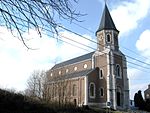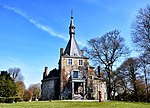Fort de Lantin

The Fort de Lantin is one of twelve forts built around Liège, Belgium, in the late 19th century. The overall Fortified Position of Liège was a constituent part of the country's National Redoubt. Fort de Lantin was built between 1881 and 1884 according to the plans of General Henri Alexis Brialmont. Contrasting with the French forts built in the same era by Raymond Adolphe Séré de Rivières, the fort was built exclusively of unreinforced concrete, a new material, rather than masonry. The fort was heavily bombarded by German artillery in the Battle of Liège. Lantin was never upgraded like the other forts of Liège and retains its character as a Brialmont fort. It is preserved as a museum and may be visited by the public.
Excerpt from the Wikipedia article Fort de Lantin (License: CC BY-SA 3.0, Authors, Images).Fort de Lantin
Rue de Villers,
Geographical coordinates (GPS) Address Nearby Places Show on map
Geographical coordinates (GPS)
| Latitude | Longitude |
|---|---|
| N 50.694694444444 ° | E 5.52575 ° |
Address
Fort de Lantin
Rue de Villers
4450
Liège, Belgium
Open on Google Maps








